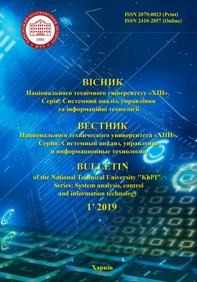IMPROVED METHOD FOR STABILITY RESEARCH OF SOLUTIONS OF SYSTEMS OF LINEAR ALGEBRAIC EQUATIONS
DOI:
https://doi.org/10.20998/2079-0023.2019.01.07Keywords:
linear algebra, numerical methods, stability, reliability, matrix, system of linear algebraic equations, determinant, modular determinant, signs table, condition numberAbstract
A review of existing methods for stability research of solutions of systems of linear algebraic equations (SLAE) depending on the input data, that is, parameter variations, have been carried out. Methods for stability research of solving systems of linear algebraic equations, such as condition numbers, modular determinants and the construction of a table of signs using the original and improved construction methods, were considered. Software for stability research of systems of linear algebraic equations have been developed. The software is using condition numbers, modular determinants, and construction of table of signs to find accurate estimates of the variations of solutions of SLAEs that depend on parameters variations.
It is shown that stability research using condition numbers gives a very rough estimate of possible errors in solutions, but that research is simple to implement, and for SLAEs it can immediately show that some systems are ill-conditioned, which saves research time, especially if SLAEs have a very large dimensionality. The stability research using modular determinants requires large calculations, but they give a fairly reliable upper estimate with respect to possible variations of individual components of solutions of systems of linear algebraic equations. This is a very important feature of the method because the individual components of solutions may experience significant variations that are not taken into account in the research using condition numbers. The study of stability by constructing a table of signs makes it possible to find the maximum variations of individual components of solutions of a system of linear algebraic equations, which in fact can be significantly less than the upper estimate of possible variations found by method of modular determinants. The paper proposes an improved method for constructing a table of signs, which finds a more accurate range of possible variations of solutions of a system of linear algebraic equations.
A comparative analysis was conducted between the traditional method of constructing a table of signs using individual determinants and an improved method of constructing a table of signs based on the derivatives of the division of determinants using the Cramer formula. According to the analysis, the improved method in 30% of cases finds variations that are 1.3 times greater than the variations that the previous method finds, and in 5% of cases these variations are 2 or more times greater than the previous ones. This suggests that the traditional method in some cases underestimated the possible deviations of solutions that depend on variations of the input data.References
Kutniv M. V. Chyselʹni metody [Numerical methods]. Lviv, Lviv Polytechnic National University Publ., 2008. 200 p.
Shakhno S. M. Chyselʹni metody liniynoyi alhebry [Numerical methods of linear algebra]. Lviv, VTS LNU im. I. Franko Publ., 2007. 245 p.
Krass M. S, Chuprynov B. P. Matematika dlya ekonomistov [Mathematics for Economists]. St. Petersburg, Piter Publ., 2005. 464 p.
Vysshaya matematika dlya ekonomistov [Higher Mathematics for Economists] N. Sh. Kremer ed. Moscow, UNITY-DANA Publ., 2007. 471 p.
Krass M. S. Matematika dlya ekonomicheskikh spetsial'nostey [Mathematics for economic specialties]. Moscow, INFRA-M Publ., 1998. 464 p.
Il'ina V. A., Silayev P. K. Chislennyye metody dlya fizikov-teoretikov. [Numerical methods for theoretical physicists]. Moscow-Izhevsk, Institute of Computer Science Publ., 2003. 132 p.
Kudryavtsev L. D. O nekotorykh matematicheskikh voprosakh teorii elektricheskikh tsepey [On Some Mathematical Questions in the Theory of Electrical Circuits]. Uspekhi Matematicheskikh Nauk. 1948, vol. 3, no. 4 (26), pp. 80–118.
Kovalenko A. A. Osnovy lineynoy algebry [Basics of linear algebra]. Barnaul, AltGPA Publ., 2010. 118 p.
Gun G. Ya. Matematicheskoye modelirovaniye protsessov obrabotki metallov davleniyem [Mathematical modeling of metal forming processes]. Moscow, Metallurgy Publ., 1983. 352 p.
Petrov Yu. P. Kak poluchat' nadezhnyye resheniya sistem uravneniy [How to obtain reliable solutions of systems of equations]. St. Petersburg, BHV-Petersburg Publ., 2012. 176 p.
Petrov Yu. P. Obespecheniye dostovernosti i nadezhnosti kom-p'yuternykh raschetov [Ensuring the reliability and reliability of computer calculations]. St. Petersburg, BHV-Petersburg Publ., 2008. 160 p.
Watkins David S. Fundamentals of Matrix Computations. 2nd Edition. New York, John Wiley & Sons, Inc., 2002 (Russ. ed.: Watkins D. S. Osnovy matrichnykh vychisleniy. Moscow, BINOM; Laboratory of Knowledge Publ., 2006. 664 p.
Demmel James W. Applied Numerical Linear Algebra. Philadelphia, Society for Industrial and Applied Mathematics, 1997 (Russ. ed.: Demmel' Dzh. Vychislitel'naya lineynaya algebra. Teoriya i prilozheniya. Moscow, Mir Publ., 2001. 430 p.
Rudenko R. O. Rozrobka prohramnoho zabezpechennya dlya doslidzhennya stiykosti chyselʹnykh metodiv liniynoyi alhebry [Software development for studying the stability of numerical methods of linear algebra]. Trudy 23-ho mizhnarodnoho molodizhnoho forumu «Radioelektronika ta molodʹ u KHKHI stolitti». T 9. [Proc. of the 23rd International Youth Forum "Radio Electronics and Youth in the 21st Century". Vol. 9]. Kharkiv, KNURE Publ., 2019, p. 130–131.
Downloads
Published
How to Cite
Issue
Section
License
Copyright (c) 2019 Bulletin of the National Technical University "KhPI". Series: System analysis, control and information technologyAuthors who publish with this journal agree to the following terms:
- Authors retain copyright and grant the journal right of first publication with the work simultaneously licensed under a Creative Commons Attribution License that allows others to share the work with an acknowledgement of the work's authorship and initial publication in this journal.
- Authors are able to enter into separate, additional contractual arrangements for the non-exclusive distribution of the journal's published version of the work (e.g., post it to an institutional repository or publish it in a book), with an acknowledgement of its initial publication in this journal.
- Authors are permitted and encouraged to post their work online (e.g., in institutional repositories or on their website) prior to and during the submission process, as it can lead to productive exchanges, as well as earlier and greater citation of published work (See The Effect of Open Access).


